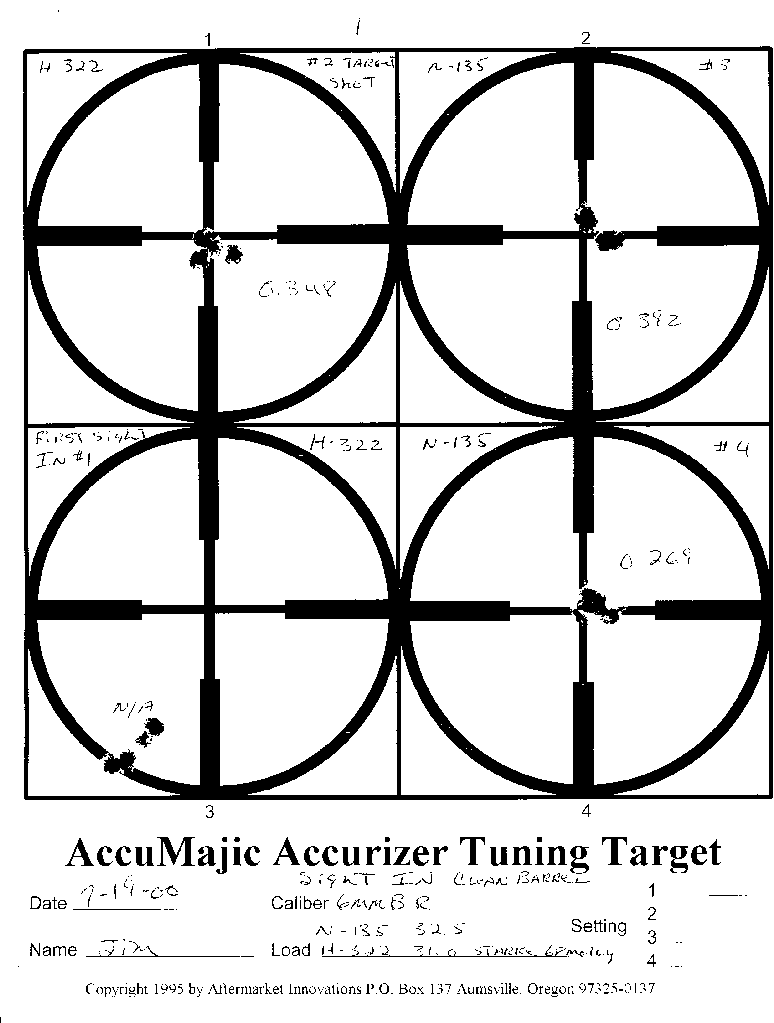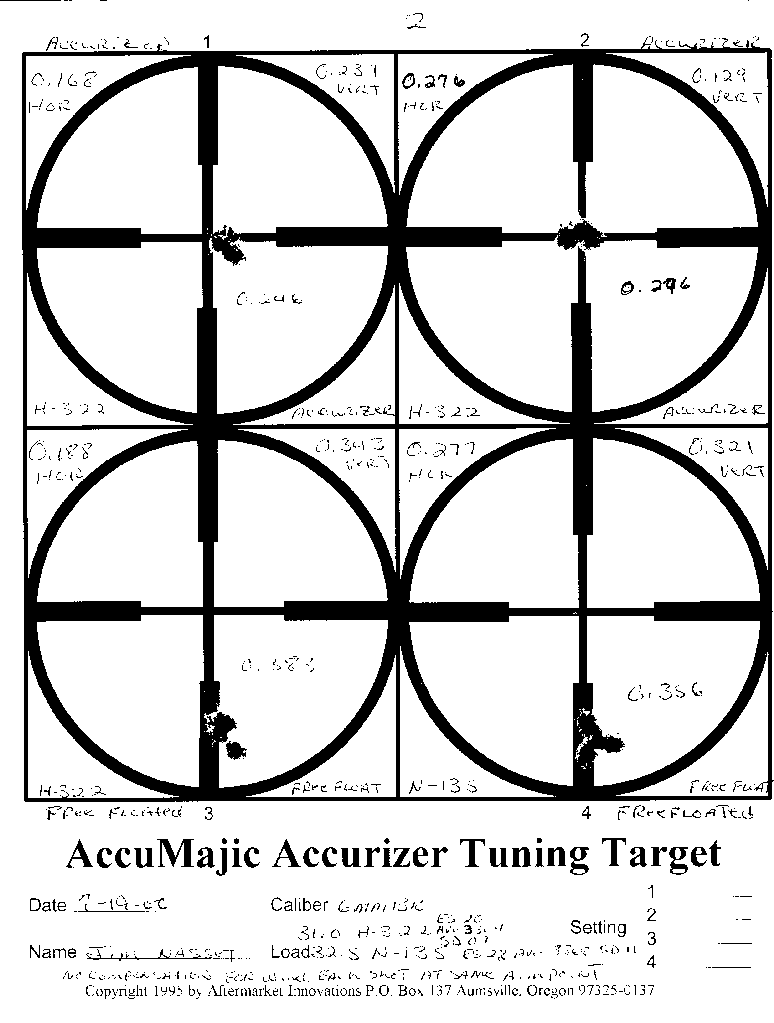
The Facts and Myths of Heat Induced Barrel Movement
The following targets were shot by me on July 19, 2000 to see if I could determine how much effect changes in barrel temperature would have at the target. I knew from the previous barrel heating experiments that I conducted (which were outlined on the previous page) that it would move substantially more when heated or cooled if it was unsupported than if it was supported but I wanted to see if this would also show up while shooting. As you can see from the following targets it does. Although it is not more than an eighth or quarter inch or so during a five shot group, during the shooting of 20 shots into 4 group targets the movement of the unsupported or "totally free-floated" barrel became quite apparent. In fact the movement of the groups was over 3/4" vertical and over 1/3" horizontally as you will see from the targets on Page 3.
The reason that you have such a small change in the vertical group size of a 5 shot group is that the change in barrel temperature only changes 5 to 10 degrees F. during the time you are shooting it. If you look at the chart on the previous page you will see that the total barrel movement of the unsupported test barrel between 80 and 90 degrees would be up to .0002" of an inch at the muzzle which would amount to nearly 0.250" of vertical at 100 Yards. This much vertical movement is often seen at benchrest matches, but may be chalked up to being caused by a wind "sprite" or inadvertent rifle movement or sighting error. Not that these aren't sometimes the cause, however, changes in barrel temperature can and do cause this kind and amount of movement.
This first target was used for sight in, and to molly coat the barrel again. After the heat testing the barrel was thoroughly cleaned with Hoppes Benchrest, Barnes 10 copper remover and JB's followed up by Kroil and dry patches. Also the scope had been re-installed from my Varmint rifle and I was using a different bullet as I was out of Berger 68 grain molly and was using Starke 68 grain molly. I also usually use VV N-135 but only had enough to load 10 rounds so I used H-322 instead a very good powder however I had not used it before. The Accurizer had been re-installed at its same position and no attempt was made to tune it during these tests. I also made no attempt to "dope the wind" but simply waited till the flags indicated the least wind and fired at the same aimpoint on each target.
Target number 1-3 was where the first shot hit after bore sighting so I was adjusting my scope to the first bullet hole, thus the angled group is not applicable to the test. I then proceeded to shoot 1-1, 1-2, and 1-4 in that order. I used the different loads as indicated on the targets. My shooting began at 1:30 PM in the afternoon. It was 73 degrees ambient with a light N to NE breeze from 3 to about 10 mph. I was shooting directly south at the target. It was a sunny day and there was a slight mirage that would show itself now and then, but nothing major. Including sight in I spent about 35 minutes shooting the four groups on target #1.
Target #1

|
1-1 |
1-2 |
1-3 |
1-4 |
| Average 3292 fps |
3366 |
N/A |
3371 |
| ES 42 |
69 |
N/A |
44 |
| SD 14 |
22 |
N/A |
14 |
|
31.0 gr. H 322 |
32.5 N 135 |
31.0 gr. H 322 |
32.5 gr. N 135 |
|
Group 0.348 |
0.392 |
N/A |
0.269 |
Target 2
The second target was shot immediately after the first. Target 2-1 and 2-2 were shot with the barrel pressure point a.k.a. Accurizer installed and using H322 powder. I then removed it and shot targets 2-3 and 2-4 with the barrel free-floated for target 2-3 I used H322 and for target 2-4 I used VV N-135. I did this to see the change in the group sizes with each powder as I had done on target #1.

|
2-1 |
2-2 |
2-3 |
2-4 |
|
Average 3299 fps |
3304 |
3304 |
3368 |
|
ES 10 |
23 |
20 |
28 |
|
SD 4 |
7 |
7 |
11 |
|
31.0 gr. H 322 |
31.0 gr. H 322 |
31.0 gr. H 322 |
32.5 gr. N 135 |
|
Group 0.246 |
0.276 |
0.383 |
0.356 |
Copyrighted by Aftermarket Innovations Salem, Oregon 2000